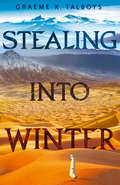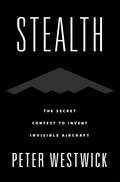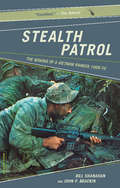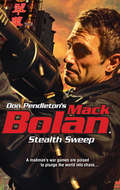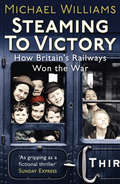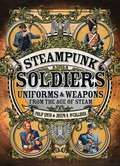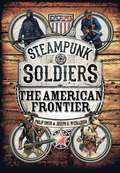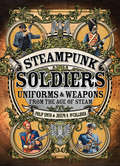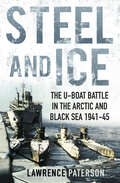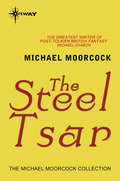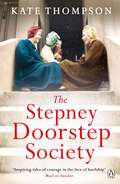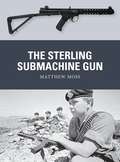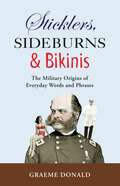- Table View
- List View
Stealing Into Winter (Shadow in the Storm #1)
by Graeme K. TalboysA breathtaking tale of adventure, survival and loyalty.
Stealth: The Secret Contest to Invent Invisible Aircraft
by Peter WestwickOn a moonless night in January 1991, a dozen U.S. aircraft appeared in the skies over Baghdad. To the Iraqi air defenses, the planes seemed to come from nowhere. Their angular shape, making them look like flying origami, rendered them virtually undetectable. Each aircraft was more than 60 feet in length and with a wingspan of 40 feet, yet its radar footprint was the size of a ball bearing. Here was the first extensive combat application of Stealth technology. And it was devastating. Peter Westwick's new book illuminates the story behind these aircraft, the F-117A, also known as the Stealth Fighter, and their close cousin the B-2, also known as the Stealth Bomber. The development of Stealth unfolded over decades. Radar has been in use since the 1930s and was essential to the Allies in World War Two, when American investment in radar exceeded that in the Manhattan Project. The atom bomb ended the war, conventional wisdom has it, but radar won it. That experience also raised a question: could a plane be developed that was invisible to radar? That question, and the seemingly impossible feat of physics and engineering behind it, took on increasing urgency during the Cold War, when the United States searched for a way both to defend its airspace and send a plane through Soviet skies undetected. Thus started the race for Stealth. At heart, Stealth is a tale of not just two aircraft but the two aerospace companies that made them, Lockheed and Northrop, guided by contrasting philosophies and outsized personalities. Beginning in the 1970s, the two firms entered into a fierce competition, one with high financial stakes and conducted at the highest levels of secrecy in the Cold War. They approached the problem of Stealth from different perspectives, one that pitted aeronautical designers against electrical engineers, those who relied on intuition against those who pursued computer algorithms. The two different approaches manifested in two very different solutions to Stealth, clearly evident in the aircraft themselves: the F-117 composed of flat facets, the B-2 of curves. For all their differences, Lockheed and Northrop were located twenty miles apart in the aerospace suburbs of Los Angeles, not far from Disneyland. This was no coincidence. The creative culture of postwar Southern California-unorthodox, ambitious, and future-oriented-played a key role in Stealth. Combining nail-biting narrative, incisive explanation of the science and technology involved, and indelible portraits of unforgettable characters, Stealth immerses readers in the story of an innovation with revolutionary implications for modern warfare.
Stealth: The Secret Contest to Invent Invisible Aircraft
by Peter WestwickOn a moonless night in January 1991, a dozen U.S. aircraft appeared in the skies over Baghdad. To the Iraqi air defenses, the planes seemed to come from nowhere. Their angular shape, making them look like flying origami, rendered them virtually undetectable. Each aircraft was more than 60 feet in length and with a wingspan of 40 feet, yet its radar footprint was the size of a ball bearing. Here was the first extensive combat application of Stealth technology. And it was devastating. Peter Westwick's new book illuminates the story behind these aircraft, the F-117A, also known as the Stealth Fighter, and their close cousin the B-2, also known as the Stealth Bomber. The development of Stealth unfolded over decades. Radar has been in use since the 1930s and was essential to the Allies in World War Two, when American investment in radar exceeded that in the Manhattan Project. The atom bomb ended the war, conventional wisdom has it, but radar won it. That experience also raised a question: could a plane be developed that was invisible to radar? That question, and the seemingly impossible feat of physics and engineering behind it, took on increasing urgency during the Cold War, when the United States searched for a way both to defend its airspace and send a plane through Soviet skies undetected. Thus started the race for Stealth. At heart, Stealth is a tale of not just two aircraft but the two aerospace companies that made them, Lockheed and Northrop, guided by contrasting philosophies and outsized personalities. Beginning in the 1970s, the two firms entered into a fierce competition, one with high financial stakes and conducted at the highest levels of secrecy in the Cold War. They approached the problem of Stealth from different perspectives, one that pitted aeronautical designers against electrical engineers, those who relied on intuition against those who pursued computer algorithms. The two different approaches manifested in two very different solutions to Stealth, clearly evident in the aircraft themselves: the F-117 composed of flat facets, the B-2 of curves. For all their differences, Lockheed and Northrop were located twenty miles apart in the aerospace suburbs of Los Angeles, not far from Disneyland. This was no coincidence. The creative culture of postwar Southern California-unorthodox, ambitious, and future-oriented-played a key role in Stealth. Combining nail-biting narrative, incisive explanation of the science and technology involved, and indelible portraits of unforgettable characters, Stealth immerses readers in the story of an innovation with revolutionary implications for modern warfare.
Stealth Patrol: The Making Of A Vietnam Ranger
by Bill Shanahan John P. BrackinFrom Stealth Patrol:"He spoke in a sort of clipped cadence, his words tumbling out quickly, one on top of the other; and his voice was deep and throaty, the way a bear might sound, if he could talk, after a night of drinking. 'Basically I'm here recruiting guys for the Lurps.... We operate in teams of five, maybe six, members apiece. In the Lurps, every man counts-and that's why we only take the best.'"Just four months after he arrived in Vietnam in 1968, Bill Shanahan joined the LRPs (Long Range Patrol). The mission of the Lurps, as they were called, was dangerous: Five- or six-man teams were dropped into the dense forest behind enemy lines. With quiet stealth, they observed enemy troop movements and staged ambushes that often ended in fierce firefights. When their mission was accomplished, they called for quick helicopter extraction. Back on base, they debriefed and tried to sleep off the adrenaline. Two days later they were back in the brush. The missions changed from week to week, but every day the goal was the same-stay alive.
Stealth Sweep
by Don PendletonA conspiracy deep within China threatens the balance of global power and stability. A rogue major from Chinese Intelligence is a mastermind with the patience and resources to spend years executing a plan of attack to expand Chinese territory into world domination.
Steam Engine - Multipage image (Large Print)
These diagrams of a steam engine are on two pages with two diagrams on the first page separated by a horizontal dashed line and one diagram on the second page. There is a locator dot shown, which will be at the top left of the page when the image is the right way up. Each diagram is titled in the top left and shows a phase of the steam engine cycle. In each diagram there is a crankshaft and axle on the left of the image. This is linked by the crosshead guide to the piston inside the cylinder on the right of the image. Sitting on the crosshead guide is the crosshead. This is linked by the control rod obliquely right up to the valve rod. The valve rod goes horizontally right through the top of the cylinder. Immediately down from the centre of the valve rod is the valve itself and down from this is steam exhaust vent (steam out). Steam is forced under pressure continuously into the steam inlet at the top right of the diagram. The crankshaft rotates anti-clockwise (with the top moving to the left) throughout all stages. In the first diagram steam flows around the valve rod and into the left side of the cylinder. This pushes the piston to the right starting the forward stroke. In the second diagram, as the stroke approaches completion, the crosshead catches the end of the control rod. In the third diagram the control rod pivots, pulling the valve rod sharply to the left. This moves the valve to the left as well. The steam now flows around the valve rod and into the right side of the cylinder. This starts the reverse stroke with the piston moving left. As it moves left it forces the low pressure exhaust steam out.
Steam Engine - Multipage image (UEB Contracted)
These diagrams of a steam engine are on two pages with two diagrams on the first page separated by a horizontal dashed line and one diagram on the second page. There is a locator dot shown, which will be at the top left of the page when the image is the right way up. Each diagram is titled in the top left and shows a phase of the steam engine cycle. In each diagram there is a crankshaft and axle on the left of the image. This is linked by the crosshead guide to the piston inside the cylinder on the right of the image. Sitting on the crosshead guide is the crosshead. This is linked by the control rod obliquely right up to the valve rod. The valve rod goes horizontally right through the top of the cylinder. Immediately down from the centre of the valve rod is the valve itself and down from this is steam exhaust vent (steam out). Steam is forced under pressure continuously into the steam inlet at the top right of the diagram. The crankshaft rotates anti-clockwise (with the top moving to the left) throughout all stages. In the first diagram steam flows around the valve rod and into the left side of the cylinder. This pushes the piston to the right starting the forward stroke. In the second diagram, as the stroke approaches completion, the crosshead catches the end of the control rod. In the third diagram the control rod pivots, pulling the valve rod sharply to the left. This moves the valve to the left as well. The steam now flows around the valve rod and into the right side of the cylinder. This starts the reverse stroke with the piston moving left. As it moves left it forces the low pressure exhaust steam out.
Steam Engine - Multipage image (UEB Uncontracted)
These diagrams of a steam engine are on two pages with two diagrams on the first page separated by a horizontal dashed line and one diagram on the second page. There is a locator dot shown, which will be at the top left of the page when the image is the right way up. Each diagram is titled in the top left and shows a phase of the steam engine cycle. In each diagram there is a crankshaft and axle on the left of the image. This is linked by the crosshead guide to the piston inside the cylinder on the right of the image. Sitting on the crosshead guide is the crosshead. This is linked by the control rod obliquely right up to the valve rod. The valve rod goes horizontally right through the top of the cylinder. Immediately down from the centre of the valve rod is the valve itself and down from this is steam exhaust vent (steam out). Steam is forced under pressure continuously into the steam inlet at the top right of the diagram. The crankshaft rotates anti-clockwise (with the top moving to the left) throughout all stages. In the first diagram steam flows around the valve rod and into the left side of the cylinder. This pushes the piston to the right starting the forward stroke. In the second diagram, as the stroke approaches completion, the crosshead catches the end of the control rod. In the third diagram the control rod pivots, pulling the valve rod sharply to the left. This moves the valve to the left as well. The steam now flows around the valve rod and into the right side of the cylinder. This starts the reverse stroke with the piston moving left. As it moves left it forces the low pressure exhaust steam out.
Steaming to Victory: How Britain's Railways Won the War
by Michael WilliamsIn the seven decades since the darkest moments of the Second World War it seems every tenebrous corner of the conflict has been laid bare, prodded and examined from every perspective of military and social history. But there is a story that has hitherto been largely overlooked. It is a tale of quiet heroism, a story of ordinary people who fought, with enormous self-sacrifice, not with tanks and guns, but with elbow grease and determination. It is the story of the British railways and, above all, the extraordinary men and women who kept them running from 1939 to 1945. Churchill himself certainly did not underestimate their importance to the wartime story when, in 1943, he praised ‘the unwavering courage and constant resourcefulness of railwaymen of all ranks in contributing so largely towards the final victory.’ And what a story it is. The railway system during the Second World War was the lifeline of the nation, replacing vulnerable road transport and merchant shipping. The railways mobilised troops, transported munitions, evacuated children from cities and kept vital food supplies moving where other forms of transport failed. Railwaymen and women performed outstanding acts of heroism. Nearly 400 workers were killed at their posts and another 2,400 injured in the line of duty. Another 3,500 railwaymen and women died in action. The trains themselves played just as vital a role. The famous Flying Scotsman train delivered its passengers to safety after being pounded by German bombers and strafed with gunfire from the air. There were astonishing feats of engineering restoring tracks within hours and bridges and viaducts within days. Trains transported millions to and from work each day and sheltered them on underground platforms at night, a refuge from the bombs above. Without the railways, there would have been no Dunkirk evacuation and no D-Day.Michael Williams, author of the celebrated book On the Slow Train, has written an important and timely book using original research and over a hundred new personal interviews.This is their story.
Steampunk Soldiers: Uniforms & Weapons from the Age of Steam (Dark Osprey)
by Philip Smith Joseph A. McCullough Mark StaceyBetween 1887 and 1895, the British art student Miles Vandercroft travelled around the world, sketching and painting the soldiers of the countries through which he passed. In this age of dramatic technological advancement, Vandercroft was fascinated by how the rise of steam technology at the start of the American Civil War had transformed warfare and the role of the fighting man. This volume collects all of Vandercroft's surviving paintings, along with his associated commentary on the specific military units he encountered. It is a unique pictorial guide to the last great era of bright and colourful uniforms, as well as an important historical study of the variety of steam-powered weaponry and equipment that abounded in the days before the Great War of the Worlds.
Steampunk Soldiers: The American Frontier
by Philip Smith Joseph A. McCullough Mark StaceyEven as the discovery and exploitation of hephaestium helped bring the Civil War to its close in 1869, the arms race it engendered resulted in a cold war just as bitter and violent as the open hostilities had been. With neither side willing to rely solely upon the talents of their scientific establishments, saboteurs, double-agents, and assassins found ample employment. Against this backdrop of suspicion and fear, thousands of Americans – Northerners and Southerners alike – headed west. Some to escape the legacies of the war, some to find their own land, some for the lure of that great undiscovered strike of hephaestium that would make them rich, and some simply to escape the law. Ahead of these pioneers stood the native tribes, behind them followed the forces of two governments, while to the north and south, foreign powers watched closely for their own opportunities. This newly unearthed collection of the works of Miles Vandercroft fills a considerable gap in our knowledge of the travels of that remarkable individual, and also provides a fascinating guide to the costume and equipment of the forces active in the great drive westwards.
Steampunk Soldiers: Uniforms & Weapons from the Age of Steam (Dark Osprey)
by Philip Smith Mr Joseph A. McCullough Mr Mark StaceyBetween 1887 and 1895, the British art student Miles Vandercroft travelled around the world, sketching and painting the soldiers of the countries through which he passed. In this age of dramatic technological advancement, Vandercroft was fascinated by how the rise of steam technology at the start of the American Civil War had transformed warfare and the role of the fighting man. This volume collects all of Vandercroft's surviving paintings, along with his associated commentary on the specific military units he encountered. It is a unique pictorial guide to the last great era of bright and colourful uniforms, as well as an important historical study of the variety of steam-powered weaponry and equipment that abounded in the days before the Great War of the Worlds.
Steampunk Soldiers: The American Frontier (Dark Ser.)
by Philip Smith Mr Joseph A. McCullough Mr Mark StaceyEven as the discovery and exploitation of hephaestium helped bring the Civil War to its close in 1869, the arms race it engendered resulted in a cold war just as bitter and violent as the open hostilities had been. With neither side willing to rely solely upon the talents of their scientific establishments, saboteurs, double-agents, and assassins found ample employment. Against this backdrop of suspicion and fear, thousands of Americans – Northerners and Southerners alike – headed west. Some to escape the legacies of the war, some to find their own land, some for the lure of that great undiscovered strike of hephaestium that would make them rich, and some simply to escape the law. Ahead of these pioneers stood the native tribes, behind them followed the forces of two governments, while to the north and south, foreign powers watched closely for their own opportunities. This newly unearthed collection of the works of Miles Vandercroft fills a considerable gap in our knowledge of the travels of that remarkable individual, and also provides a fascinating guide to the costume and equipment of the forces active in the great drive westwards.
Steel and Ice: The U-Boat Battle in the Arctic and Black Sea 1941-45
by Lawrence PatersonThe U-boat war against Russia was as fierce and unrelenting as the land war that raged along the Eastern Front between 1941 and 1945. From Wolf Pack attacks on Russian convoy traffic and military vessels to close-quarter combat undertaken by small U-boats transported by land and river to the Black Sea, the Kriegsmarine wrestled for control of the seas fringing an embattled Soviet Union. Previously untold in English, Lawrence Paterson explores the tremendous clash between the Kriegsmarine’s U-boats and the Red Navy – a struggle that lasted from the opening salvos of Operation Barbarossa to the final chaotic days of Germany’s defeat. Containing rare colour and black-and-white illustrations, this fascinating book is one that no one interested in the Second World War should be without.
Steel Fist: Tank Warfare 1939-45
by Nigel Cawthorne"If the tanks succeed, then victory follows."General Heinz Guderian, 1937After seeing the success of the British tanks in the First World War, the Germans decided that the future of warfare lay in the Panzerkampfwagen, the armoured fighting vehicle, later simply known as the Panzer. In time, the Panzer Corps would become the German army's new vanguard, an essential component of the new style of war that came to be known as Blitzkrieg - 'lightning war'.Steel Fist looks at the development of the Panzer concept, and the building and deployment of the Corps through the eyes of those who fought it. It tells the story of how the Panzers formed the spearhead of the world's most efficient military machine, and how they were ultimately defeated.
The Steel Girls (The\steel Girls Ser. #Book 1)
by Michelle RawlinsWhen war breaks out, friendship will see them through ‘A heart-warming story perfect for saga lovers’, Nancy Revell,Sunday Times bestselling author of The Shipyard Girls series
Steel Girls at War (The Steel Girls #4)
by Michelle RawlinsPre-order the next book in the heart-warming WW2 historical romance saga series, The Steel Girls In their darkest days, they’ll find the courage to carry on…
Steel Girls on the Home Front (The Steel Girls #3)
by Michelle RawlinsAs the war rages on, can they be there for each other?
The Steel Tsar (Nomad Of The Time Streams Ser.)
by Michael MoorcockIn his epic adventures in the alternative Twentieth Centuries, Chrononaut Oswald Bastable, member of the League of Temporal Adventurers, has crossed and re-crossed many different time-streams. Some of his previous experiences have been told in The Land Leviathan and The Warlord of the Air.Now, in what may be the last communication from him, he tells of a world in which the Bolshevik Revolution never happened...The Steel Tsar finds him travelling backwards in time from a shell-shocked Singapore to a Russian Empire seething with conflict and preyed on by motley bands of rogues and adventurers. Here he meets up with fellow-time-traveler Miss Una Persson, and together they change the course of a history whose legendary deeds exceed the bounds of everyday imagination and glitter in the exuberant land of the eternal present.
The Sten Gun (Weapon)
by Leroy Thompson Alan Gilliland Mr Mark StaceyThe Sten submachine gun – officially the 'Carbine, Machine, Sten' – was developed to fulfill the pressing British need for large quantities of cheaply produced weapons after Dunkirk, when German invasion was a very real possibility. Over four million were built during World War II, and the Sten was widely used by airborne troops, tankers, and others who needed a compact weapon with substantial firepower. It proved especially popular with Resistance fighters as it was easy to conceal, deadly at close range, and could fire captured German ammunition – with a design so simple that Resistance fighters were able to produce them in bicycle shops. Featuring vivid first-hand accounts, specially commissioned full-colour artwork and close-up photographs, this is the fascinating story of the mass-produced submachine gun that provided Allied soldiers and Resistance fighters with devastating close-range firepower.
The Sten Gun (Weapon)
by Leroy Thompson Mark Stacey Alan GillilandThe Sten submachine gun – officially the 'Carbine, Machine, Sten' – was developed to fulfill the pressing British need for large quantities of cheaply produced weapons after Dunkirk, when German invasion was a very real possibility. Over four million were built during World War II, and the Sten was widely used by airborne troops, tankers, and others who needed a compact weapon with substantial firepower. It proved especially popular with Resistance fighters as it was easy to conceal, deadly at close range, and could fire captured German ammunition – with a design so simple that Resistance fighters were able to produce them in bicycle shops. Featuring vivid first-hand accounts, specially commissioned full-colour artwork and close-up photographs, this is the fascinating story of the mass-produced submachine gun that provided Allied soldiers and Resistance fighters with devastating close-range firepower.
The Stepney Doorstep Society: The remarkable true story of the women who ruled the East End through war and peace (A\history Of Urban Society In Europe Ser.)
by Kate ThompsonThe unsung and remarkable stories of the women who held London's East End together during not one, but two world wars._____________Minksy, Gladys, Beatty, Joan, Girl Walker. While the men were at war, these women ruled the streets of the East End. Brought up with firm hand in the steaming slums and teeming tenements, they struggled against poverty to survive, and fought for their community in our country's darkest hours.But there was also joy to be found. From Stepney to Bethnal Green, Whitechapel to Shoreditch, the streets were alive with peddlers and market stalls hawking their wares, children skipping across dusty hopscotch pitches, the hiss of a gas lamp or the smell of oxtail stew. You need only walk a few steps for a smile from a neighbour or a strong cup of tea.From taking over the London Underground, standing up to the Kray twins and crawling out of bombsites, The Stepney Doorstep Society tells the vivid and moving stories of the matriarchs who remain the backbone of the East End to this day.
The Sterling Submachine Gun (Weapon)
by Adam Hook Alan Gilliland Matthew MossDesigned by a motorcycle racer turned small-arms engineer, George Patchett, the submachine gun that eventually became known as the Sterling was developed during World War II. Some suggest it first saw action during Operation Infatuate with No. 4 Commando, before becoming fully adopted by the British Army in 1953 as the Sterling Machine Carbine (L2A1). It was centre stage for many of Britain's post-colonial conflicts from Malaya to Kenya and from Yemen to Northern Ireland. The silenced L34A1 Sterling-Patchett entered service in 1966 and first saw action deep in the jungles of Vietnam in the hands of the elite special forces of Australia, New Zealand and the United States during prisoner snatches and reconnaissance patrols.Employing first-hand accounts and painstaking technical analysis, this engaging account features carefully selected archive photography and specially commissioned colour artwork depicting the submachine gun that armed British and other forces for nearly 60 years.
The Sterling Submachine Gun (Weapon #65)
by Mr Adam Hook Alan Gilliland Matthew MossDesigned by a motorcycle racer turned small-arms engineer, George Patchett, the submachine gun that eventually became known as the Sterling was developed during World War II. Some suggest it first saw action during Operation Infatuate with No. 4 Commando, before becoming fully adopted by the British Army in 1953 as the Sterling Machine Carbine (L2A1). It was centre stage for many of Britain's post-colonial conflicts from Malaya to Kenya and from Yemen to Northern Ireland. The silenced L34A1 Sterling-Patchett entered service in 1966 and first saw action deep in the jungles of Vietnam in the hands of the elite special forces of Australia, New Zealand and the United States during prisoner snatches and reconnaissance patrols.Employing first-hand accounts and painstaking technical analysis, this engaging account features carefully selected archive photography and specially commissioned colour artwork depicting the submachine gun that armed British and other forces for nearly 60 years.
Sticklers, Sideburns and Bikinis: The military origins of everyday words and phrases
by Graeme Donald Andrew Wiest William ShepherdDid you know they started 'hearing through the grapevine' during the American Civil War, that 'ghettos' originated in Venice or that 'deadline' has a very sinister origin? Jam-packed with many amazing facts, Fighting Talk is a fascinating trip through the words and phrases that came to us from the military but nowadays are used by soldier and civilian alike. The sources of many are surprising and their original use is often far removed from that of today. From 'duds' to 'freelancers' and 'morris dancing' to 'bikini' this enthralling book describes the military origins of words and phrases that we use on a daily basis.
